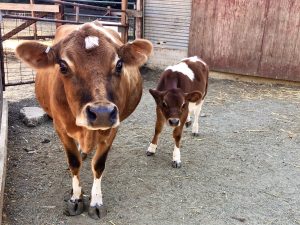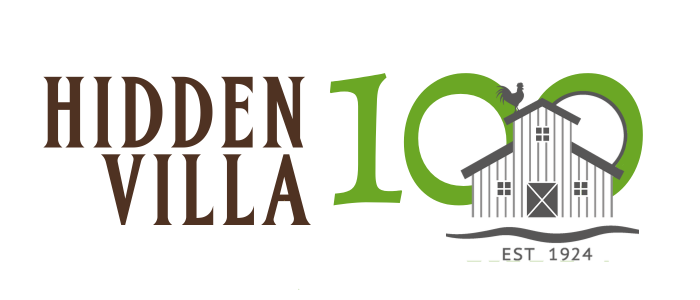
Summary:
Cows provide us with milk and meat, among other things. Like all animals, they have tools, called adaptations, also known as structures that function to help them survive. As domestic animals, most of their needs are met by their farmers but they still retain the tools that helped their ancestors gather food and feel safe in the wild.
Know-It-All
1. Emelie is a miniature Jersey cow. When she grows up, she will weigh about 700 pounds and give 2-4 gallons of milk a day. Larger, black and white Holstein cows give up to nine gallons of milk per day and weigh up to 1300 pounds. Why do you think Hidden Villa’s farmer chose Jersey cows instead of Holsteins?
2. Dairy products are things made from milk. How many can you name?
3. Cows are mammals. What makes an animal a mammal? When do mammals give milk?
4. Cows like Emelie are dairy cows. They give us milk. Some cows are beef cows. They give us meat. Meat contains protein for building strong muscles. Do you eat meat? What kind? If you are a vegetarian, where do you get your protein?
5. Emelie grew up on another farm and was moved in a trailer to her new home at Hidden Villa. Have you ever been the “new kid”, in your neighborhood or in school? How did that feel?
Digging Deeper
Watch this cool video about the life of a miniature Jersey cow in Connecticut! https://youtu.be/tJoBvQgHvO4
Try It
It’s time to get creative! Now that you have watched the Cow video, we hope you are inspired to try some of the suggestions below. Just have fun with it!
A. Cow Ears
• Cows have large ears to hear sounds that might mean danger. They want to be able to get away long before a predator gets close. They have much better hearing than humans! But, with this activity, you can hear as well as a cow! Here’s how: Make your hands into cup shapes, curving your fingers and squeezing them together. Put your hands behind your ears. Your thumbs should be below your ears and your pointer fingers should be above. At Hidden Villa, we call these “deer ears” because deer have the same, large ears as cows!
• With your hands cupping your ears, turn your head slowly from left to right. You should be able to hear much better than when you are just using your ears.
• Focus on an interesting sound. Maybe someone is cooking in the kitchen, maybe someone is playing music, maybe a pet is walking around. While facing the sound, put your deer ears on and then take them away. What a difference!
• Finally, head outside and try out those deer ears. You will be amazed by the many sounds around you! Which sounds are made by humans? Which sounds are made by other animals? Can you hear the wind?
B. Ear Construction
• Try to make a set of deer ears out of construction paper or any kind of thick paper. Make a few versions to compare: round ears, tall ears square ears, whatever you’d like. Compare your different-shaped ears. Which ones work best?
• Test your “new ears”. Ask a family member to help. Go outside and have the other person talk in a low voice as they move away from you. Mark the spot when you can no longer hear them. Now, try each set of deer ears and mark the spot again. How much farther away was the spot when you used deer ears? Which set helped you hear the person from the farthest away?
C. Utterly Ridiculous
Cows produce milk to feed their babies. After the calf is done nursing, farmers collect the cow’s milk for us by squeezing it out of the cow’s udder. You can practice this at home!
Ask a grown up for a rubber glove and a pin or needle. Carefully poke a hole in the end of each finger of the glove. Fill the glove with water and tie off the opening, like you would tie a balloon closed. Have someone hold the glove over a bowl. Take one of the glove’s fingers in each hand. Your pointer fingers should be facing each other and your thumbs should be wrapped around the glove’s finger that is full of water. Pinch your thumb and pointer finger together and use the rest of your fingers to squeeze the glove fingers toward a bowl or bucket. Wow! You’re milking!
Print out the guide by downloading the PDF
